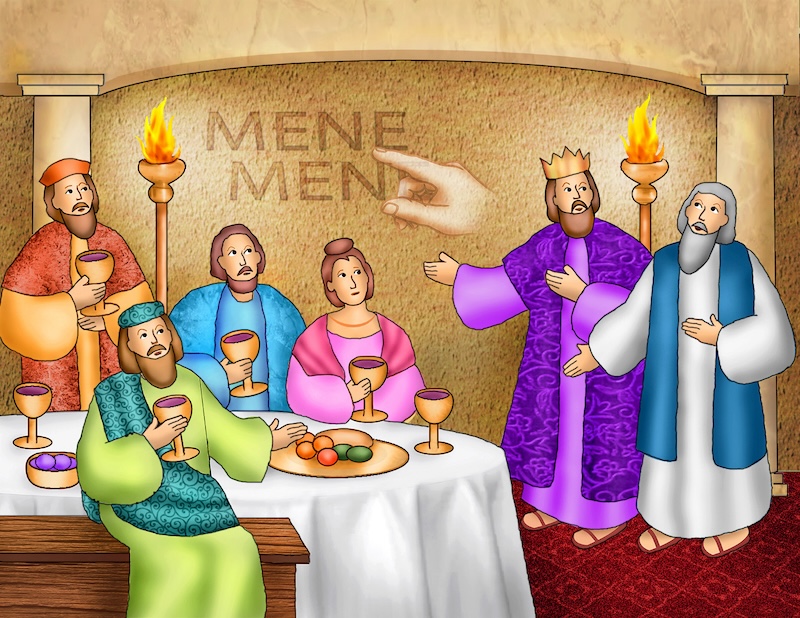CHILDREN’S STORY:
One day, King Belshazzar, the pagan king of Babylon, gave a great banquet at his palace for 1,000 of his lords.
During the feast, the king ordered that gold and silver vessels be brought in so that he, his lords, his wives and the entertainers could drink from them.
These vessels were very special. One of the previous kings of Babylon, Nebuchadnezzar, had taken them from the Jewish Temple in Jerusalem when he ransacked the city and brought its citizens to Babylon as captives.
As the people drank from the sacred vessels, they praised their pagan gods of gold, silver, bronze, iron, wood and stone.
Suddenly, the fingers of a human hand appeared and began writing in the plaster on the wall.
When the king saw the hand, the color drained from his face. He was so terrified that the joints of his hips shook and his knees knocked together.
The king ordered Daniel to be brought before him. Daniel was a Jew who had been brought to Babylon as a captive. He also was a prophet of God and, in the past, had interpreted Nebuchadnezzar’s dream.
The king said he would give Daniel valuable items and a position of power in the kingdom if he could reveal the meaning of the words written on the wall: MENE, TEKEL and PERES.
Daniel refused the king’s gifts but said he would read the words and tell him what they meant.
“You have rebelled against the Lord of heaven,” Daniel said, explaining that the king had praised false gods while drinking from the Temple vessels. “But the God in whose hand is your life breath and the whole course of your life, you did not glorify. By him were the wrist and hand sent, and the writing set down.”
Then Daniel interpreted the meaning of the three words that had been written on the wall.
MENE, he said, meant that God had numbered Belshazzar’s kingdom and put an end to it.
TEKEL meant that Belshazzar had been weighed on the scales and was found wanting.
And PERES meant that the kingdom of Babylon had been divided and given to the Medes and Persians.
READ MORE ABOUT IT:
Daniel 5
Q&A
- What did the king see on the wall?
- Who did the king ask for help?
TRIVIA: What happened to King Belshazzar after Daniel interpreted the writing on the wall? (Hint: Daniel 5:30)
Answer: He was slain that night.
BIBLE ACCENT:
In Daniel 2, we read that Daniel interpreted a dream for King Nebuchadnezzar.
The king had asked the wise men of Babylon to interpret the dream for him without actually telling them what it was about.
Daniel learned of the king’s request and asked for time to interpret the dream. During the night, God gave Daniel a vision in which the dream and its meaning were revealed.
Daniel asked to see the king. He described the king’s dream, which was about a very large and bright statue with a head of gold; a chest and arms of silver; a belly of bronze; legs of iron; and feet that were partly iron and partly tile.
Daniel explained that the statue’s head represented Babylon, and the other parts represented various kingdoms that would take Babylon’s place. A stone that struck the statue’s feet and made the entire thing crumble represented the kingdom that God would create to put an end to other kingdoms and that would not be destroyed.
The king was so pleased that he made Daniel ruler of the whole province of Babylon.
SAINT FOR TODAY:
St. Juan Diego
St. Juan Diego was a native Mexican who was born near present-day Mexico City in 1474. He converted to Christianity and was baptized at the age of 50.
On Dec. 9, 1531, he was walking to Mass when Mary appeared to him on Tepeyac Hill. She asked him to ask the bishop to have a shrine built there.
The bishop asked for a sign that would prove the request was from Mary, so Juan returned to the hill on Dec. 12, 1531. Mary told him to pick flowers that were blooming atop the hill and carry them in his cloak to the bishop. When Juan opened the cloak, the flowers fell out, revealing the image of Our Lady of Guadalupe adorning his garment.
Juan lived the remainder of his life as a hermit near the first chapel built on the hill. He died in 1548, and we remember him on Dec. 9.
PUZZLE:
Using the hints provided, fill in the blanks about the prophet Daniel.
- In Babylon, Daniel’s name was changed to _______. (Daniel 1:7)
- Daniel asked for _______ to eat and _______ to drink. (Daniel 1:12)
- King Belshazzar gave Daniel a _______ chain. (Daniel 5:29)
- King Darius threw Daniel into a _______ den. (Daniel 6:17)
Answers: 1. Belteshazzar; 2. vegetables, water; 3. gold; 4. lion’s

